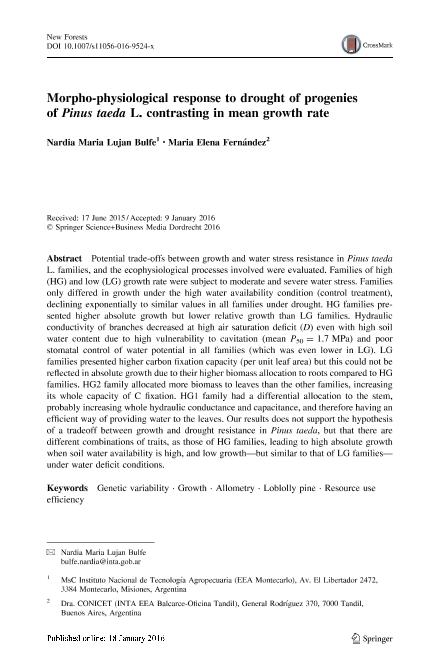Mostrar el registro sencillo del ítem
dc.contributor.author
Bulfe, Nardia Maria Lujan
dc.contributor.author
Fernandez, Maria Elena

dc.date.available
2019-03-07T20:08:43Z
dc.date.issued
2016-05
dc.identifier.citation
Bulfe, Nardia Maria Lujan; Fernandez, Maria Elena; Morpho-physiological response to drought of progenies of Pinus taeda L. contrasting in mean growth rate; Springer; New Forests; 47; 3; 5-2016; 431-451
dc.identifier.issn
0169-4286
dc.identifier.uri
http://hdl.handle.net/11336/71206
dc.description.abstract
Potential trade-offs between growth and water stress resistance in Pinus taeda L. families, and the ecophysiological processes involved were evaluated. Families of high (HG) and low (LG) growth rate were subject to moderate and severe water stress. Families only differed in growth under the high water availability condition (control treatment), declining exponentially to similar values in all families under drought. HG families presented higher absolute growth but lower relative growth than LG families. Hydraulic conductivity of branches decreased at high air saturation deficit (D) even with high soil water content due to high vulnerability to cavitation (mean P50 = 1.7 MPa) and poor stomatal control of water potential in all families (which was even lower in LG). LG families presented higher carbon fixation capacity (per unit leaf area) but this could not be reflected in absolute growth due to their higher biomass allocation to roots compared to HG families. HG2 family allocated more biomass to leaves than the other families, increasing its whole capacity of C fixation. HG1 family had a differential allocation to the stem, probably increasing whole hydraulic conductance and capacitance, and therefore having an efficient way of providing water to the leaves. Our results does not support the hypothesis of a tradeoff between growth and drought resistance in Pinus taeda, but that there are different combinations of traits, as those of HG families, leading to high absolute growth when soil water availability is high, and low growth—but similar to that of LG families—under water deficit conditions.
dc.format
application/pdf
dc.language.iso
eng
dc.publisher
Springer

dc.rights
info:eu-repo/semantics/openAccess
dc.rights.uri
https://creativecommons.org/licenses/by-nc-sa/2.5/ar/
dc.subject
Allometry
dc.subject
Genetic Variability
dc.subject
Growth
dc.subject
Loblolly Pine
dc.subject
Resource Use Efficiency
dc.subject.classification
Agricultura

dc.subject.classification
Agricultura, Silvicultura y Pesca

dc.subject.classification
CIENCIAS AGRÍCOLAS

dc.title
Morpho-physiological response to drought of progenies of Pinus taeda L. contrasting in mean growth rate
dc.type
info:eu-repo/semantics/article
dc.type
info:ar-repo/semantics/artículo
dc.type
info:eu-repo/semantics/publishedVersion
dc.date.updated
2019-03-06T13:50:24Z
dc.journal.volume
47
dc.journal.number
3
dc.journal.pagination
431-451
dc.journal.pais
Alemania

dc.journal.ciudad
Berlin
dc.description.fil
Fil: Bulfe, Nardia Maria Lujan. Instituto Nacional de Tecnología Agropecuaria. Centro Regional Misiones. Estación Experimental Agropecuaria Montecarlo; Argentina
dc.description.fil
Fil: Fernandez, Maria Elena. Consejo Nacional de Investigaciones Científicas y Técnicas; Argentina. Instituto Nacional de Tecnología Agropecuaria. Centro Regional Buenos Aires Sur. Estación Experimental Agropecuaria Balcarce; Argentina
dc.journal.title
New Forests

dc.relation.alternativeid
info:eu-repo/semantics/altIdentifier/doi/https://dx.doi.org/10.1007/s11056-016-9524-x
dc.relation.alternativeid
info:eu-repo/semantics/altIdentifier/url/https://link.springer.com/article/10.1007/s11056-016-9524-x
Archivos asociados
